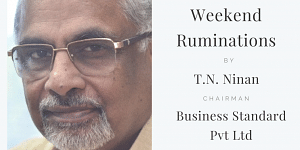India may soon cross a perhaps unique tipping point, when its export of services becomes bigger than its export of merchandise (other than oil and gems & jewellery). Over the first four months of this financial year, services exports fetched $74.05 billion, not far short of what was fetched by merchandise exports, excluding oil and gems/jewellery: $79.81 billion. Since the first is growing at over 8 per cent, and the second at less than 2 per cent, the tipping point may be no more than a year or two away.
This would be an extraordinary development, and not necessarily something to celebrate. Globally, services trade accounts for less than 20 per cent of the total. In India’s case, if one takes all of exports (including oil and gems/jewellery), the share of services is 40 per cent. One could argue that it is in fact more: The export of gems and jewellery is classified as merchandise trade, though in reality what is being exported is the value created by the work of people who cut and polish imported diamond roughs and work on precious metals (also imported). Whatever the official classification, this is export of services.

There is supreme irony in this services-manufacturing denouement. When the US first proposed, in the 1980s, that a new round of global trade talks should be expanded in scope to include not just merchandise trade but also trade in services, India was a stout critic of the idea of opening up markets for trade in services. My fellow-columnist TCA Srinivasa-Raghavan was one of the few who saw that India might have a competitive advantage in this area (we have cheaper technologists, doctors, accountants, space scientists, etc than almost all other countries). But his voice was lost in the anti-American cacophony.
Today, the boot is well and truly on the other foot. In the prolonged negotiations for RCEP (Regional Cooperation for Economic Partnership), India has been offering a two-sector deal to the leading economies of the Asia-Pacific: If they open up on services trade, New Delhi will open up further on merchandise trade. There have been no takers so far, and RCEP is stuck.
Also read: Behind India’s chronic trade deficit, a few ignorant accounting formulas
Consider other ironies. Among the things that India is pushing for is liberalisation of something classified as “Mode 4” in the multilateral trade services agreement. This covers the movement of “natural persons”; the blunt argument is that other countries must allow more work migrants from India (think H-1B). The counter-argument from across the table is precisely the one that India uses to try and stop the flow of migrants from Bangladesh: The movement of “natural persons” is a citizenship issue, not one of trade. Common sense tells us it is both.
There is nothing which says countries must be consistent; they can and do follow their perceived self-interest. So what should concern those in charge of economic affairs is not the tactical nature of negotiating positions but the structural flaw at the heart of the Indian economy, which finds reflection in the export pattern: The failure of domestic manufacturing, specifically the Make in India programme, and the consequentially outsize share of GDP and trade accounted for by services. Bear in mind that high-value services exports create fewer jobs than manufacturing (think vendors, dealers, after-sales servicing).
Yet, the likely prospect is that the manufacturing-services imbalance will grow. It is easier to realise the untapped potential of some forms of services export than it is to improve the country’s physical infrastructure, which today hobbles manufacturing. The relatively high cost of power, land, and transport, along with steep port charges and shipping rates, combines with inefficiencies in the labour market, all of it made worse by an unrealistic exchange rate for the rupee, to limit manufacturing exports. Indeed, as services exports continue to succeed, the rupee will become stronger and large parts of the manufacturing sector, with their smaller profit margins, will find it steadily harder to compete internationally. This will almost certainly result in a shortage of domestic job opportunities for millions of rural youngsters who have acquired a basic education and who do not wish to go back to tilling the land.
By Special Arrangement with Business Standard
Also read: Ambitious economic targets could embarrass Modi govt if it doesn’t show greater purpose




We need the greenbacks, whether they come from services or merchandise exports. India also needs the jobs, but let at least one major issue be taken care of. In India’s case, service exports brings to mind IT and software. On tourism, our citizens probably now spend more abroad than foreigners do in India. Banking, shipping, insurance, where are the other major service exports coming from ?
There is only 1 fly in the ointment – the assertion that: Indeed, as services exports continue to succeed, the rupee will become stronger – historically there is no proof for such an occurrence. And they’re by the core assumption of the thesis is dodgy.
I welcome is someone can show it otherwise, but the best of scholarship currently doesn’t support the argument.
Dear Sir,
Why cant the rural youth who are educated join the services industry.
Kenya is attempting to promote this in a big way. India can too, I run an organization that employs 1000 people in Indian villages working for the processes from all across the world.
mani
DesiCrew